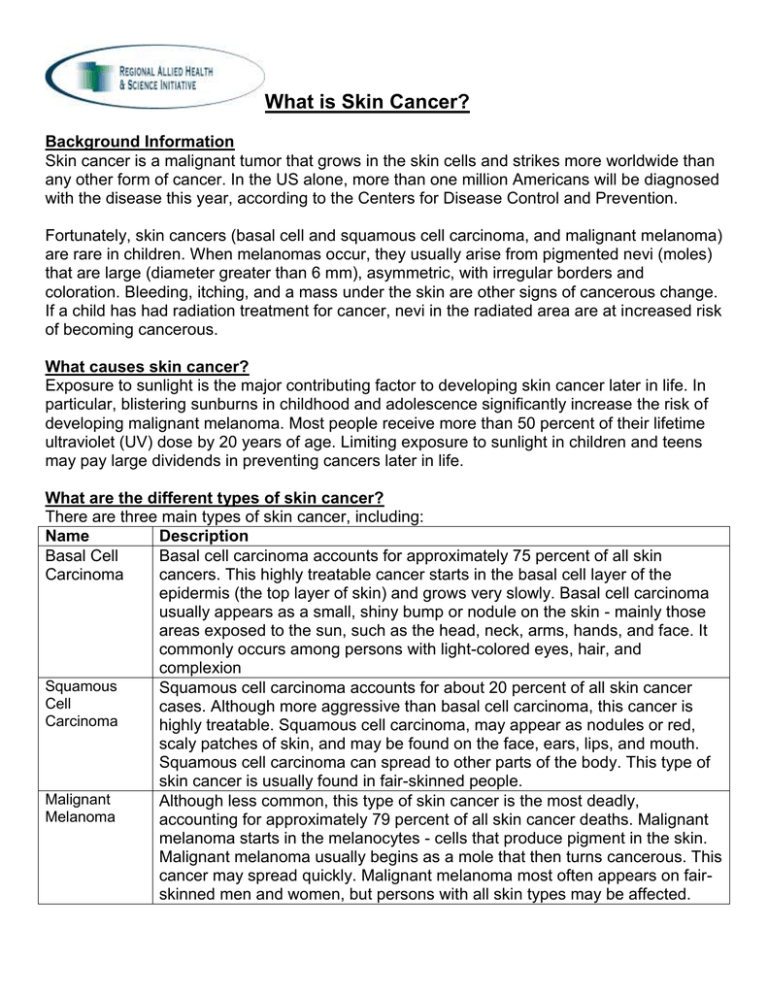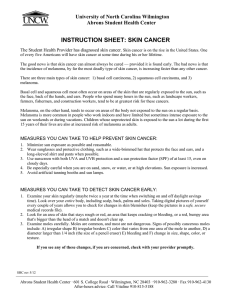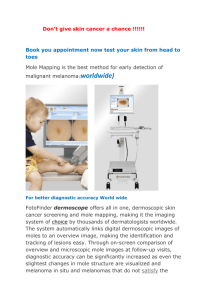Skin Cancer Identification Worksheet: Mole Analysis
advertisement

What is Skin Cancer? Background Information Skin cancer is a malignant tumor that grows in the skin cells and strikes more worldwide than any other form of cancer. In the US alone, more than one million Americans will be diagnosed with the disease this year, according to the Centers for Disease Control and Prevention. Fortunately, skin cancers (basal cell and squamous cell carcinoma, and malignant melanoma) are rare in children. When melanomas occur, they usually arise from pigmented nevi (moles) that are large (diameter greater than 6 mm), asymmetric, with irregular borders and coloration. Bleeding, itching, and a mass under the skin are other signs of cancerous change. If a child has had radiation treatment for cancer, nevi in the radiated area are at increased risk of becoming cancerous. What causes skin cancer? Exposure to sunlight is the major contributing factor to developing skin cancer later in life. In particular, blistering sunburns in childhood and adolescence significantly increase the risk of developing malignant melanoma. Most people receive more than 50 percent of their lifetime ultraviolet (UV) dose by 20 years of age. Limiting exposure to sunlight in children and teens may pay large dividends in preventing cancers later in life. What are the different types of skin cancer? There are three main types of skin cancer, including: Name Description Basal Cell Basal cell carcinoma accounts for approximately 75 percent of all skin Carcinoma cancers. This highly treatable cancer starts in the basal cell layer of the epidermis (the top layer of skin) and grows very slowly. Basal cell carcinoma usually appears as a small, shiny bump or nodule on the skin - mainly those areas exposed to the sun, such as the head, neck, arms, hands, and face. It commonly occurs among persons with light-colored eyes, hair, and complexion Squamous Squamous cell carcinoma accounts for about 20 percent of all skin cancer Cell cases. Although more aggressive than basal cell carcinoma, this cancer is Carcinoma highly treatable. Squamous cell carcinoma, may appear as nodules or red, scaly patches of skin, and may be found on the face, ears, lips, and mouth. Squamous cell carcinoma can spread to other parts of the body. This type of skin cancer is usually found in fair-skinned people. Malignant Although less common, this type of skin cancer is the most deadly, Melanoma accounting for approximately 79 percent of all skin cancer deaths. Malignant melanoma starts in the melanocytes - cells that produce pigment in the skin. Malignant melanoma usually begins as a mole that then turns cancerous. This cancer may spread quickly. Malignant melanoma most often appears on fairskinned men and women, but persons with all skin types may be affected. How can I distinguishing benign moles from melanoma? To prevent melanoma, it is important to examine your child's skin on a regular basis, and become familiar with moles, and other skin conditions, in order to better identify changes. According to recent research, certain moles are at higher risk for changing into malignant melanoma. Moles that are present at birth and atypical moles, have a greater chance of becoming malignant. Recognizing changes in your child's moles, by following this ABCD Chart, is crucial in detecting malignant melanoma at its earliest stage. The warning signs are: Melanomas vary greatly in appearance. Some melanomas may show all of the ABCD characteristics, while other may only show changes in one or two characteristics. What are the risk factors for melanoma? Skin cancer is more common in fair-skinned people - especially those with blond or red hair, who have light-colored eyes. However, no one is safe from skin cancer. Almost half of all Americans who live to age 65 will be diagnosed with skin cancer at some point in their lives, according to the National Cancer Institute. Other risk factors include: Family history of melanoma. Sun exposure - The amount of time spent unprotected in the sun directly Affects your child's risk of skin cancer. Early childhood sunburns - Research has shown that sunburns early in life. Increase a child's risk for skin cancer later in life. Sun exposure early in life is the major contributing factor to developing skin cancer. Many freckles. Many ordinary moles (more than 50). Dysplastic nevi. How can I prevent skin cancer? The American Academy of Dermatology (AAD) has declared WAR on skin cancer by recommending these three preventive steps: 1. Wear protective clothing, including a hat with a four-inch brim. 2. Apply sunscreen all over your child's body and avoid the midday sun from 10 a.m. to 4 p.m. (Keep infants under 6 months of age out of direct sunlight at all times.) 3. Regularly use a broad-spectrum sunscreen with an SPF of 15 or higher, even on cloudy days. Remember, sand and pavement reflect UV rays even under the umbrella. Snow is a particularly good reflector of UV rays. Reflective surfaces can reflect up to 85 percent of the damaging sun rays. Name(s): ___________________ __________________________ Date: ___________ Period: Activity – Identifying Possible Skin Cancer ____ Finding suspicious moles or skin cancer early is the key to treating skin cancer successfully. Examining yourself is usually the first step in detecting skin cancer. You are a family physician and you have several patients that are coming in to have their moles looked at for possible melanoma. For each of the following patients use the ABCD chart to identify whether their moles are suspicious for melanoma. In the box below each mole image write a summary paragraph answering the following: 1. Is there a possibility the mole is cancerous and why/why not? 2. What is your advice to the patient for this mole? (none, proper sun care, removal, etc.) Patient 1 Information Patient is a 73 yr.old Caucasian female with fair skin who has had 3 melanomas removed in the past 2 years. She is a self-confessed beach bum and has been since 1950. It is located on her right shoulder and 6 mm. ___________________________________________________ ___________________________________________________ ___________________________________________________ ___________________________________________________ ___________________________________________________ ___________________________________________________ ___________________________________________________ Patient 2 Information Patient is 10 yr.old Caucasian male with very fair skin who has no history of skin cancer, but every member of his family has. He has had average sun exposure and it is located 3 inches distal of his left elbow and is 4 mm. ___________________________________________________ ___________________________________________________ ___________________________________________________ ___________________________________________________ ___________________________________________________ ___________________________________________________ ___________________________________________________ Patient 3 Information Patient is 30 yr. old Native American female with medium skin tone with no history of skin cancer. She has had very little sun exposure and it is located on the medial side of her right knee and is 14 mm. ___________________________________________________ ___________________________________________________ ___________________________________________________ ___________________________________________________ ___________________________________________________ ___________________________________________________ ___________________________________________________ Patient 4 Information Patient is a 65 yr. old Caucasian male with very fair skin and this is his 3rd visit for this mole as it has been changing shape. He has had average skin exposure and his father died from melanoma at age 49. It is located on the posterior torso under the right shoulder blade. Use the ruler to find the measurement. ___________________________________________________ ___________________________________________________ ___________________________________________________ ___________________________________________________ ___________________________________________________ ___________________________________________________ ___________________________________________________ Patient 5 Information Patient is a 69 yr. old Caucasian female with fair skin. She has recently moved to the country and this is the first time she has had this mole looked at. It has been developing since she was in her late teens. It is located on her left cheek and is 13 mm. ___________________________________________________ ___________________________________________________ ___________________________________________________ ___________________________________________________ ___________________________________________________ ___________________________________________________ ___________________________________________________ Patient 6 Information Patient is a 29 yr. old Hispanic male who has had 2 two suspicious moles removed. He has had extensive sun exposure and it is located on the middle of his right forearm. It is 4 mm. ___________________________________________________ ___________________________________________________ ___________________________________________________ ___________________________________________________ ___________________________________________________ ___________________________________________________ ___________________________________________________ Patient 7 Information Patient is a 4 yr. old African American male who was born with albinism. The mole has developed quickly over the last 2 months from 3 mm to 24 mm and is located on the dorsal surface of his left foot. ___________________________________________________ ___________________________________________________ ___________________________________________________ ___________________________________________________ ___________________________________________________ ___________________________________________________ ___________________________________________________ Patient 8 Information Patient is a 42 yr. old Asian female with no history of skin cancer. She just noticed this mole on her lower back last week and is not sure how long she has had it. Use the ruler to find the measurement. ___________________________________________________ ___________________________________________________ ___________________________________________________ ___________________________________________________ ___________________________________________________ ___________________________________________________ ___________________________________________________ Patient 9 Information Patient is a 15 yr. old Hispanic female with no history of skin cancer. The mole has been present since birth and remained relatively the same size at 8 mm. It is located lateral to her left eye. ___________________________________________________ ___________________________________________________ ___________________________________________________ ___________________________________________________ ___________________________________________________ ___________________________________________________ ___________________________________________________ Patient 10 Information Patient is a 40 yr. old Caucasian female who has had several moles removed that were suspicious for skin cancer. The mole is located on the left side of her neck and is 6 mm. ___________________________________________________ ___________________________________________________ ___________________________________________________ ___________________________________________________ ___________________________________________________ ___________________________________________________ ___________________________________________________ Patient 11 Information Patient is an 89 yr. old male who recently completed chemotherapy for lymphoma. He has had average sun exposure and the mole has grown in size over the past year from 3 mm to 14 mm. ___________________________________________________ ___________________________________________________ ___________________________________________________ ___________________________________________________ ___________________________________________________ ___________________________________________________ ___________________________________________________





